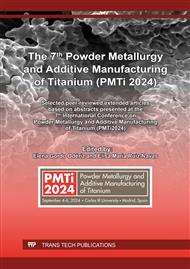[1]
N. Wu, F. Xue, H. Yang, G. Li, F. Luo, and J. Ruan, Effects of TiB2 particle size on the microstructure and mechanical properties of TiB2-based composites, Ceram. Int. 45(1) (2019) 1370–1378
DOI: 10.1016/J.CERAMINT.2018.08.270
Google Scholar
[2]
M. Shamekh, M. Pugh, and M. Medraj, Fabrication and reaction mechanism of in-situ TiC and TiB2 reinforced Mg matrix composites, Adv. Mat. Res. 409 (2012) 215–220
DOI: 10.4028/www.scientific.net/AMR.409.215
Google Scholar
[3]
B.V. Radhakrishna Bhat, J. Subramanyam, and V.V. Bhanu Prasad, Preparation of Ti-TiB-TiC & Ti-TiB composites by in-situ reaction hot processing, Mater. Sci. Eng. A 325(1–2) (2002) 126–130
DOI: 10.1016/S0921-5093(01)01412-5
Google Scholar
[4]
V.V. Rielli, V. Amigó-Borrás, and R.J. Contieri, Microstructural evolution and mechanical properties of in-situ as-cast beta titanium matrix composites, J. Alloys Compd. 778 (2019) 186–196
DOI: 10.1016/J.JALLCOM.2018.11.093
Google Scholar
[5]
S.C. Tjong and Z.Y. Ma, Microstructural and mechanical characteristics of in situ metal matrix composites, Mater. Sci. Eng. R Rep. 29(3) (2000) 49–113
DOI: 10.1016/S0927-796X(00)00024-3
Google Scholar
[6]
I.Y. Kim, B.J. Choi, Y.J. Kim, and Y.Z. Lee, Friction and wear behavior of titanium matrix (TiB+TiC) composites, Wear 271(9–10) (2011) 1962–1965
DOI: 10.1016/j.wear.2010.12.072
Google Scholar
[7]
B.-J. Choi, I.-Y. Kim, Y.-Z. Lee, and Y.-J. Kim, Microstructure and friction/wear behavior of (TiB+TiC) particulate-reinforced titanium matrix composites, Wear 318(1) (2014) 68–77
DOI: 10.1016/j.wear.2014.05.013
Google Scholar
[8]
C. Arévalo, M. Kitzmantel, E. Neubauer, and I. Montealegre-Meléndez, Development of Ti-MMCs by the use of different reinforcements via conventional Hot-Pressing, Key Eng. Mater. 704 (2016) 400-405
DOI: 10.4028/www.scientific.net/KEM.704.400
Google Scholar
[9]
I. Montealegre-Meléndez, E. Neubauer, C. Arévalo, A. Rovira, and M. Kitzmantel, Study of Titanium Metal Matrix Composites Reinforced by Boron Carbides and Amorphous Boron Particles Produced via Direct Hot Pressing, Key Eng. Mater. 704 (2016) 85–93
DOI: 10.4028/www.scientific.net/KEM.704.85
Google Scholar
[10]
X. Wang, L. Wang, L.S. Luo, Y.J. Xu, X.Z. Li, R.R. Chen, Y.Q. Su, J.J. Guo, and H.Z. Fu, Hydrogen induced softening and hardening for hot workability of (TiB + TiC)/Ti-6Al-4V composites, Int. J. Hydrog. Energy 42(5) (2017) 3380–3388
DOI: 10.1016/j.ijhydene.2017.01.030
Google Scholar
[11]
E. Ariza, I. Montealegre-Meléndez, C. Arévalo, M. Kitzmantel, and E. Neubauer, Ti/B4C composites prepared by in situ reaction using Inductive Hot Pressing, Key Eng. Mater. 742 (2017) 121–128
DOI: 10.4028/www.scientific.net/KEM.742.121
Google Scholar
[12]
I. Montealegre-Meléndez, C. Arévalo, E.M. Pérez-Soriano, M. Kitzmantel, and E. Neubauer, Microstructural and XRD analysis and study of the properties of the system Ti-TiAl-B4C processed under different operational conditions, Metals 8(5) (2018) 367
DOI: 10.3390/met8050367
Google Scholar
[13]
C. Arévalo, I. Montealegre-Meléndez, E. Ariza, M. Kitzmantel, C. Rubio-Escudero, and E. Neubauer, Influence of sintering temperature on the microstructure and mechanical properties of in situ reinforced titanium composites by Inductive Hot Pressing, Materials 9(11) (2016) 919
DOI: 10.3390/ma9110919
Google Scholar
[14]
I. Montealegre Meléndez, E. Neubauer, and H. Danninger, Consolidation of titanium matrix composites to maximum density by different Hot Pressing techniques, Mater. Sci. Eng. A 527(16–17) (2010) 4466–4473
DOI: 10.1016/J.MSEA.2010.03.093
Google Scholar
[15]
I. Montealegre Melendez, E. Neubauer, P. Angerer, H. Danninger, and J.M. Torralba, Influence of nano-reinforcements on the mechanical properties and microstructure of titanium matrix composites, Compos. Sci. Technol. 71(8) (2011) 1154–1162
DOI: 10.1016/J.COMPSCITECH.2011.04.005
Google Scholar
[16]
C. Arévalo, I. Montealegre-Melendez, E.M. Pérez-Soriano, E. Ariza, M. Kitzmantel, and E. Neubauer, Study of the Influence of TiB Content and Temperature in the Properties of In Situ Titanium Matrix Composites, Metals 7(11) (2017) 457
DOI: 10.3390/met7110457
Google Scholar
[17]
ASTM C373-14; Standard Test Method for Water Absorption, Bulk Density, Apparent Porosity, and Apparent Specific Gravity of Fired Whiteware Products, Ceramic Tiles, and Glass Tiles. ASTM: West Conshohocken, PA, USA, 2014.
DOI: 10.1520/c0373-14
Google Scholar
[18]
D. Jiang, H. Cui, X. Zhao, H. Chen, G. Ma, and X. Song, "Reaction mechanism and friction behavior of an in-situ Ti/B4C composite synthesized by spark plasma sintering," Ceram Int, vol. 48, no. 23, p.34341–34349, Dec. 2022.
DOI: 10.1016/J.CERAMINT.2022.07.358
Google Scholar



